Qualitative Analysis of Risks Affecting the Delivery of Land Surveying Project Activities
Abstract
:1. Introduction
- (a)
- Examining the agreement between the contractors and consultants for the assessment of the risk factors’ probabilities and impacts on both time and accuracy in land surveying projects.
- (b)
- Presenting a general overview for the risk factors’ probabilities and their impacts on the time and accuracy in land surveying projects to determine the most critical of the risk factors. It is essential to generate awareness of these factors and their probability of occurrence, as well as to examine the level to which they have high impacts on the project objectives.
- (c)
- Studying and comparing the impacts and weights of each activity on the time and accuracy in land surveying projects, so that efforts can be completed to control these reasons, share practical results, and examine their relative importance.
- (d)
- Determining who is responsible for each risk factor and categorizing them into groups based on the responsibility, as well as evaluating these responsibility groups.
2. Risk Overview
2.1. Risk Analysis
2.2. Risk Analysis in Construction Projects
3. Research Methodology
4. LSPs’ Activity Groups
5. Data Collection, Analysis, and Discussion
5.1. Field Survey Design
5.2. Experiences of Respondents
5.3. Agreement Analysis
5.4. Evaluation of Time of LSPs
5.5. Evaluation of Accuracy of LSPs
6. Qualitative Analysis for Risk Factors Effects on LSPs
- PI represents the probability index for a certain risk factor;
- Pi represents the probability weight;
- n represents the number of participants who responded;
- EFi represents the experience factor: (EF1 = 1 for 5–10 years, EF2 = 1.6 for
- 10–15 years, EF3 = 2.3 for 15–20 years, and EF4 = 3 for above 20 years);
- IIT represents the impact index for time;
- Iti represents the impact weight for time;
- IIA represents the impact index for accuracy;
- Iai represents the impact weight for accuracy;
- Pi, Iit, and Iia represent constants expressing the weight (0.1, 0.3, 0.5, 0.7, or 0.9) given to the ith response.
6.1. Risk Indices’ Correlations
6.2. Key Risk Factors
6.3. Analysis Based on Risk Groups Effects
6.3.1. The Party Chief
6.3.2. Professional Land Surveyor
6.3.3. The Assistant Surveyor
6.3.4. Office Engineer
6.4. Analysis Based on Responsibility
7. Conclusions
- Many agreements tests were conducted based on risk factors ranking by consultants and contractors through three developed indices corresponding to the possibility of occurrence, the influence on time, and the influence on accuracy. The weight of respondents’ experiences was considered through calculations.
- There is a positive correlation between the number of risk factors affecting each activity group and the time weight represented by the same group. For example, in activity group (C), which is affected by 24 risk factors and represented by about 55% of all factors, it consumes 83% from total time.
- About 74% of the LSPs meet the proposed time or faces minimum time delay, while about 76% of these projects satisfy specifications and meet high accuracy.
- For risk factors’ assessment, two severity indices (RFIT and RFIA) were developed and determined by combining effects of the possibility of occurrence with the influences of risk factors on time and accuracy. The values of RFIA were found to be higher than their counterparts in RFIT.
- Not all risk factors appear together in first top ten ranked risk factors related to time and accuracy. For example, the risk factor arranged first in the case of time does not appear in the first top ten in the case of accuracy.
- Most of the key risk factors that affect both time and accuracy were located in activity group (C). For example, risk factor No. 16, concerning the transfer of the instrument and sights from one control point to another, was considered the most vital factor that affects both time and accuracy. On the other hand, risk factor No. 23, which concerns taking measurements at inappropriate times, is ordered first in the case of time, while it does not appear in accuracy first top ten.
- The standard deviation and mean values for RFIA in case of all risk factors are greater than in the case of RFIT values, while the mean values of RFIA are higher than those for RFIT in all activity groups except activity group (A).
- The boxplot analysis displayed that the values of developed indices for time and accuracy for activity group (A) were adjacent, whereas the values for activity group (C) presented a convergence. The widest range of RFIT and RFIA values was found for activity group (B). Risk factors occupied outliers, and appeared only in activity group (C). It can be clarified that activity groups (B) and (C) are close in their values, except outliers’ factors. Based on all factors, the range in the case of time is higher than that of accuracy.
- The surveyor has the highest responsibility for most of risk factors, followed by the chief and assistant surveyor, while the office engineer is denoted the lowest responsibility. Most of the responsibilities for the risk factors are single and few are shared by only two responsibilities.
- Although activity group (C) is considered the riskiest group, there is no responsibility for the chief in that group, while all responsibilities for the assistance appear in this group.
Author Contributions
Funding
Institutional Review Board Statement
Informed Consent Statement
Data Availability Statement
Acknowledgments
Conflicts of Interest
References
- Puniach, E.; Kwartnik-Pruc, A. The Use of Laser Scanning and Unmanned Aerial Vehicles in Construction Surveying in the Light of Legal Regulations in Poland. J. Appl. Eng. Sci. 2018, 8, 79–88. [Google Scholar] [CrossRef]
- Division of Plats and Surveys, Maryland State Highway Administration. Survey Field Procedures Manual; Division of Plats and Surveys, Maryland State Highway Administration: Baltimore, MD, USA, 2001.
- Ana-Cornelia, B.; Gheorghe, B.; Silviu, C.T. Some Elements of Project Management Using Dedicated SOftware in the Land Surveying Works. In Proceedings of the International Multidisciplinary Scientific GeoConference: SGEM, Albena, Bulgaria, 17–23 June 2012; Volume 2, p. 1147. [Google Scholar]
- Abd El-Karim, M.S.B.A.; Mosa El Nawawy, O.A.; Abdel-Alim, A.M. Identification and assessment of risk factors affecting construction projects. HBRC J. 2017, 13, 202–216. [Google Scholar] [CrossRef]
- Guan, L.; Abbasi, A.; Ryan, M.J. Analyzing green building project risk interdependencies using Interpretive Structural Modeling. J. Clean. Prod. 2020, 256, 120372. [Google Scholar] [CrossRef]
- Issa, U.H.; Marouf, K.G.; Faheem, H.B. Analysis of risk factors affecting the main execution activities of roadways construction projects. J. King Saud Univ. —Eng. Sci. 2021. [Google Scholar] [CrossRef]
- Taroun, A. Towards a better modelling and assessment of construction risk: Insights from a literature review. Int. J. Proj. Manag. 2014, 32, 101–115. [Google Scholar] [CrossRef]
- Mosaad, S.; Issa, U.H.; Hassan, M.S. Risks affecting the delivery of HVAC systems: Identifying and analysis. J. Build. Eng. 2018, 16, 20–30. [Google Scholar] [CrossRef]
- Zayed, T.; Amer, M.; Pan, J. Assessing risk and uncertainty inherent in Chinese highway projects using AHP. Int. J. Proj. Manag. 2008, 26, 408–419. [Google Scholar] [CrossRef]
- Issa, U.H.; Farag, M.A.; Abdelhafez, L.M.; Ahmed, S.A. A risk allocation model for construction projects in Yemen. Civ. Environ. Res. 2015, 7, 78–89. [Google Scholar]
- Rezakhani, P. Fuzzy MCDM model for risk factor selection in construction projects. Eng. J. 2012, 16, 79–93. [Google Scholar] [CrossRef]
- Rezakhani, P. Fuzzy risk analysis model for construction projects. Int. J. Civ. Struct. Eng. 2011, 2, 516–531. [Google Scholar] [CrossRef]
- Nieto-Morote, A.; Ruz-Vila, F. A fuzzy approach to construction project risk assessment. Int. J. Proj. Manag. 2011, 29, 220–231. [Google Scholar] [CrossRef] [Green Version]
- Issa, U.H. Developing an Assessment Model for Factors Affecting the Quality in the Construction Industry. J. Civ. Eng. Archit. 2012, 6, 504–512. [Google Scholar] [CrossRef] [Green Version]
- Yazdani-Chamzini, A. Proposing a new methodology based on fuzzy logic for tunnelling risk assessment. J. Civ. Eng. Manag. 2014, 20, 82–94. [Google Scholar] [CrossRef]
- Abd El Khalek, H.; Aziz, R.F.; Aziz, K.H.; Kamel, H. International construction projects’ risk cost estimation: Fuzzy logic and AHP in application (Real case studies). J. Build. Sustain. 2017, 2, 1–30. [Google Scholar]
- Zhou, H.; Zhao, Y.; Shen, Q.; Yang, L.; Cai, H. Risk assessment and management via multi-source information fusion for undersea tunnel construction. Autom. Constr. 2020, 111, 103050. [Google Scholar] [CrossRef]
- Yan, H.; Gao, C.; Elzarka, H.; Mostafa, K.; Tang, W. Risk assessment for construction of urban rail transit projects. Saf. Sci. 2019, 118, 583–594. [Google Scholar] [CrossRef]
- Yuan, T.; Xiang, P.; Li, H.; Zhang, L. Identification of the main risks for international rail construction projects based on the effects of cost-estimating risks. J. Clean. Prod. 2020, 274, 122904. [Google Scholar] [CrossRef]
- Chang, W.-T.; Lin, C.J.; Lee, Y.-H.; Chen, H.-J. Development of an observational checklist for falling risk assessment of high-voltage transmission tower construction workers. Int. J. Ind. Ergon. 2018, 68, 73–81. [Google Scholar] [CrossRef]
- Shi, Y.; Du, J.; Ahn, C.R.; Ragan, E. Impact assessment of reinforced learning methods on construction workers’ fall risk behavior using virtual reality. Autom. Constr. 2019, 104, 197–214. [Google Scholar] [CrossRef]
- Chen, F.; Wang, H.; Xu, G.; Ji, H.; Ding, S.; Wei, Y. Data-driven safety enhancing strategies for risk networks in construction engineering. Reliab. Eng. Syst. Saf. 2020, 197, 106806. [Google Scholar] [CrossRef]
- Mohandes, S.R.; Zhang, X. Towards the development of a comprehensive hybrid fuzzy-based occupational risk assessment model for construction workers. Saf. Sci. 2019, 115, 294–309. [Google Scholar] [CrossRef]
- Jebelli, H.; Ahn, C.R.; Stentz, T.L. Fall risk analysis of construction workers using inertial measurement units: Validating the usefulness of the postural stability metrics in construction. Saf. Sci. 2016, 84, 161–170. [Google Scholar] [CrossRef]
- Sanni-Anibire, M.O.; Mahmoud, A.S.; Hassanain, M.A.; Salami, B. A risk assessment approach for enhancing construction safety performance. Saf. Sci. 2020, 121, 15–29. [Google Scholar] [CrossRef]
- Wong, T.K.M.; Man, S.S.; Chan, A.H.S. Critical factors for the use or non-use of personal protective equipment amongst construction workers. Saf. Sci. 2020, 126, 104663. [Google Scholar] [CrossRef]
- Man, S.; Chan, A.H.; Wong, H. Risk-taking behaviors of Hong Kong construction workers—A thematic study. Saf. Sci. 2017, 98, 25–36. [Google Scholar] [CrossRef]
- Man, S.S.; Chan, A.H.S.; Alabdulkarim, S. Quantification of risk perception: Development and validation of the construction worker risk perception (CoWoRP) scale. J. Saf. Res. 2019, 71, 25–39. [Google Scholar] [CrossRef] [PubMed]
- Issa, U.H.; Salama, I.M. Improving Productivity in Saudi Arabian Construction Projects: An Analysis based on Lean Techniques. Int. J. Appl. Eng. Res. 2018, 13, 8669–8678. [Google Scholar]
- Adeleke, A.; Bahaudin, A.; Kamaruddeen, A.M.; Bamgbade, J.; Salimon, M.G.; Khan, M.W.A.; Sorooshian, S. The Influence of Organizational External Factors on Construction Risk Management among Nigerian Construction Companies. Saf. Health Work 2018, 9, 115–124. [Google Scholar] [CrossRef]
- Issa, U.H.; Mosaad, S.A.; Hassan, M.S. Evaluation and selection of construction projects based on risk analysis. Structures 2020, 27, 361–370. [Google Scholar] [CrossRef]
- Wang, Z.; Chen, C. Fuzzy comprehensive Bayesian network-based safety risk assessment for metro construction projects. Tunn. Undergr. Space Technol. 2017, 70, 330–342. [Google Scholar] [CrossRef]
- Leontaris, G.; Nápoles, O.M.; Dewan, A.; Wolfert (Rogier), A.R.M. Decision support for offshore asset construction using expert judgments for supply disruptions risk. Autom. Constr. 2019, 107, 102903. [Google Scholar] [CrossRef]
- Farooq, M.U.; Thaheem, M.J.; Arshad, H. Improving the risk quantification under behavioural tendencies: A tale of construction projects. Int. J. Proj. Manag. 2018, 36, 414–428. [Google Scholar] [CrossRef]
- Shojaei, P.; Haeri, S.A.S. Development of supply chain risk management approaches for construction projects: A grounded theory approach. Comput. Ind. Eng. 2019, 128, 837–850. [Google Scholar] [CrossRef]
- Barriuso, Á.R.; Escribano, B.V.; Cañamares, M.S.; García, M.G.; Sáiz, A.R. Analysis and diagnosis of risk-prevention training actions in the Spanish construction sector. Saf. Sci. 2018, 106, 79–91. [Google Scholar] [CrossRef]
- Gunduz, M.; Laitinen, H. Construction safety risk assessment with introduced control levels. J. Civ. Eng. Manag. 2018, 24, 11–18. [Google Scholar] [CrossRef] [Green Version]
- Issa, U.H.; Mosaad, S.A.; Hassan, M.S. A model for evaluating the risk effects on construction project activities. J. Civ. Eng. Manag. 2019, 25, 687–699. [Google Scholar] [CrossRef]
- Issa, U.; Sharaky, I.; Alwetaishi, M.; Balabel, A.; Shamseldin, A.; Abdelhafiz, A.; Al-Surf, M.; Al-Harthi, M.; Osman, M. Developing and Applying a Model for Evaluating Risks Affecting Greening Existing Buildings. Sustainability 2021, 13, 6403. [Google Scholar] [CrossRef]
- Minchin, M.; WestOne Services. Introduction to Surveying; WestOne Services: Nokomis, FL, USA, 2003. [Google Scholar]
- Galvin, R. How many interviews are enough? Do qualitative interviews in building energy consumption research produce reliable knowledge? J. Build. Eng. 2015, 1, 2–12. [Google Scholar] [CrossRef]
- Thomas, A.V.; Kalidindi, S.N.; Ananthanarayanan, K. Risk perception analysis of BOT road project participants in India. Constr. Manag. Econ. 2003, 21, 393–407. [Google Scholar] [CrossRef]
- Issa, U.H.; Ahmed, A.; Ugai, K. A Decision Support System for Ground Improvement Projects Using Gypsum Waste Case Study: Embankments Construction in Japan. J. Civ. Environ. Res. 2013, 4, 74–84. [Google Scholar]
- Townsend, K. Saturation and run off: How many interviews are required in qualitative research. In Proceedings of the ANZAM Conference 2013, Hobart, Australia, 4–6 December 2013. [Google Scholar]
- Long, N.D.; Ogunlana, S.; Quang, T.; Lam, K.C. Large construction projects in developing countries: A case study from Vietnam. Int. J. Proj. Manag. 2004, 22, 553–561. [Google Scholar] [CrossRef]
- Osman, M.M.A.; Issa, U.H.; Eraqi, A.M.Z. Identifying the Risk Impact on Cost and Time of the Egyptian Non-Residential Buildings Projects. Int. J. Sci. Res. Sci. Eng. Technol. 2020, 7, 1–12. [Google Scholar] [CrossRef]
- Tukey, J.W. Exploratory Data Analysis; SAGE Publications: Thousand Oaks, CA, USA, 1977; Volume 2. [Google Scholar]
- Mishiyi, H.; Cumberlege, R.; Buys, F. Challenges facing newly established quantity surveying firms to secure tenders in South Africa. Acta Structilia 2019, 26, 42–60. [Google Scholar] [CrossRef] [Green Version]

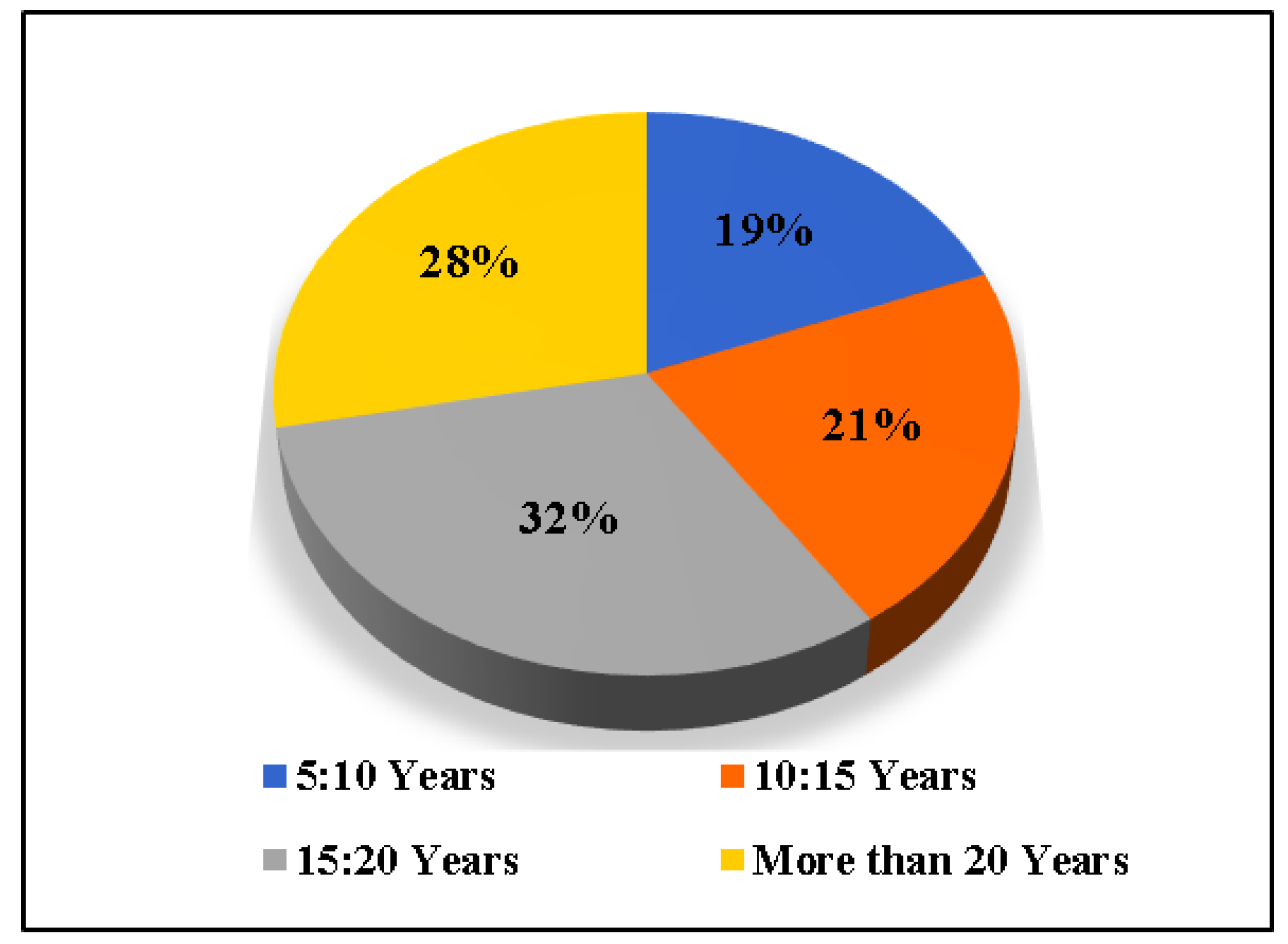

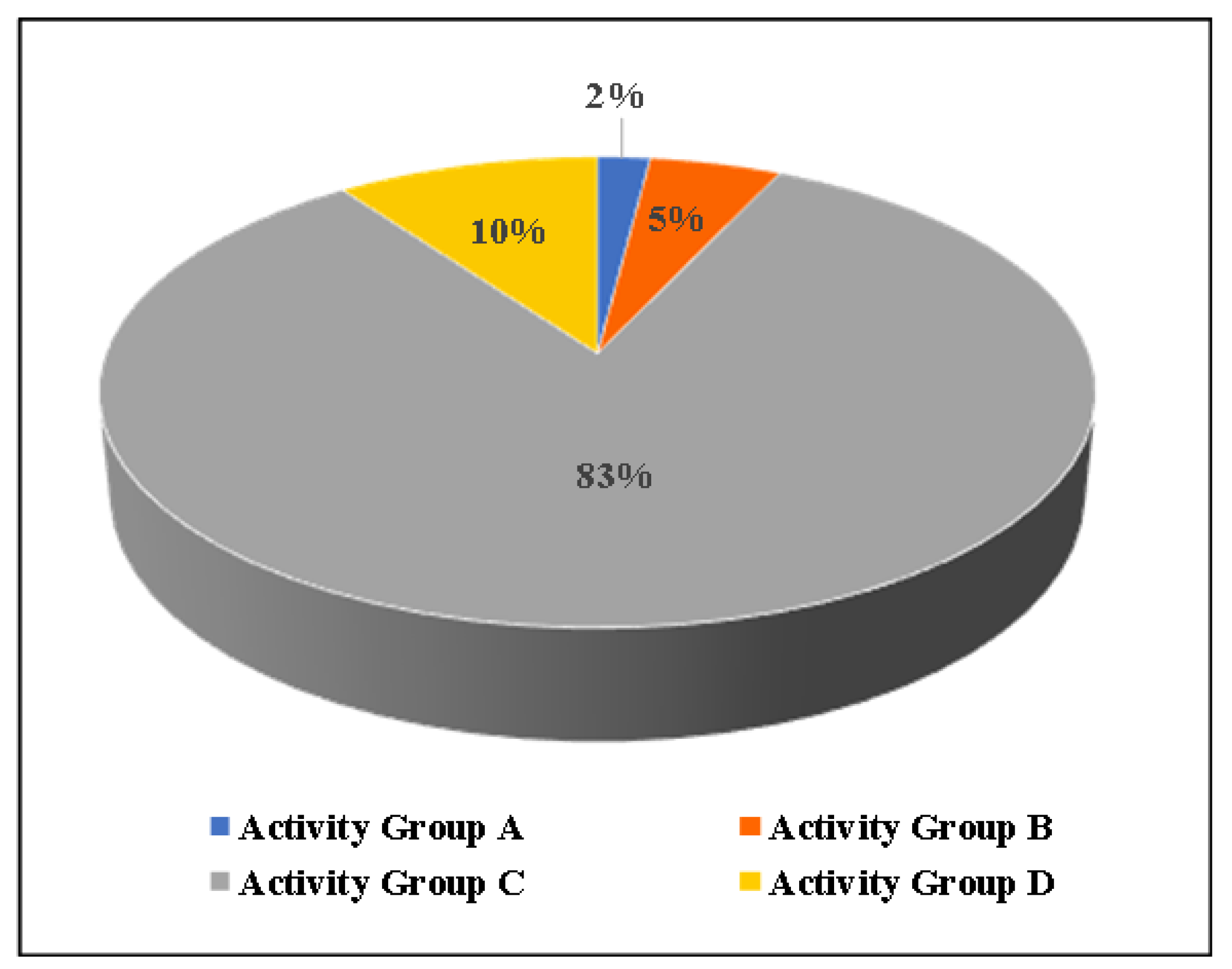
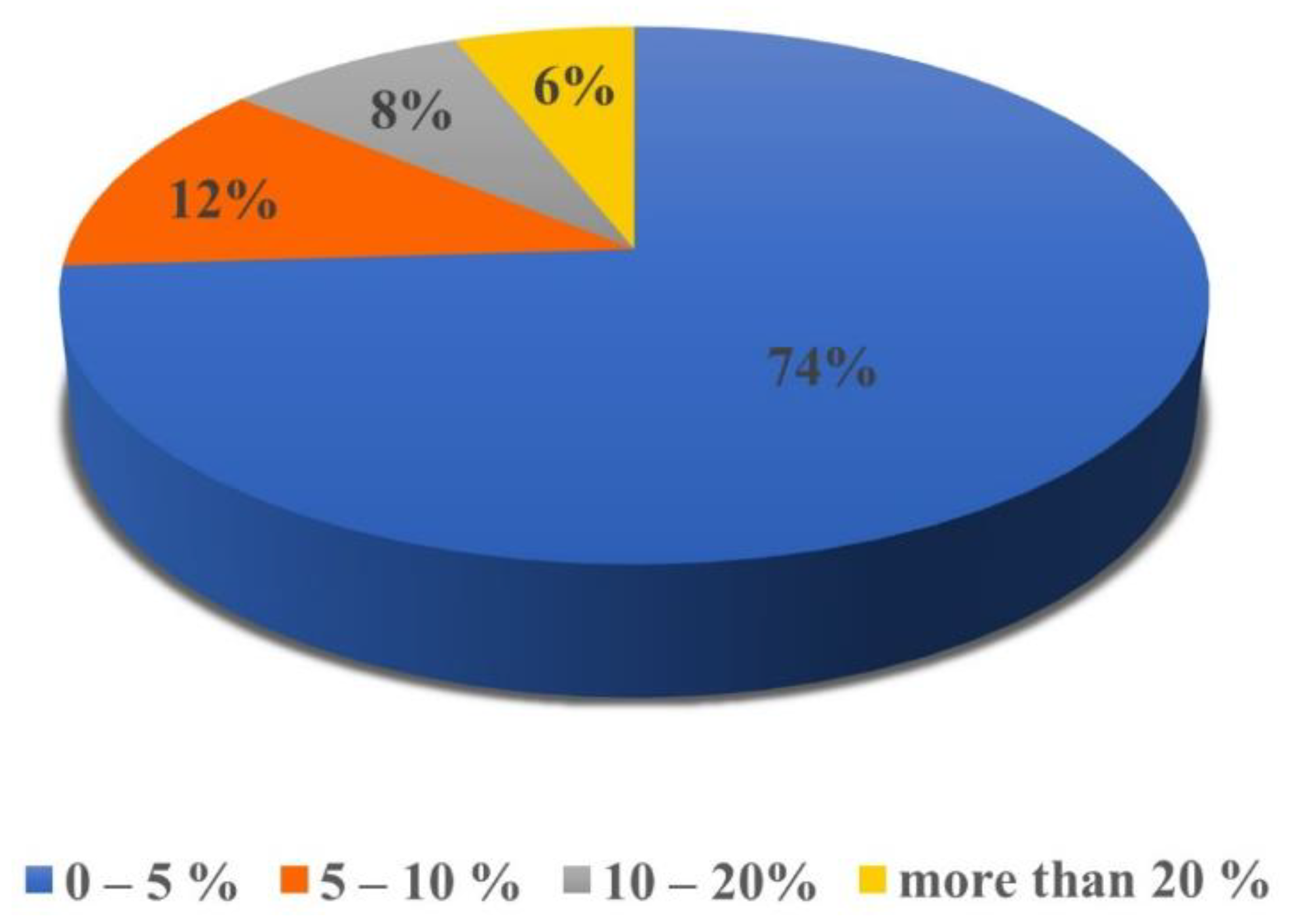
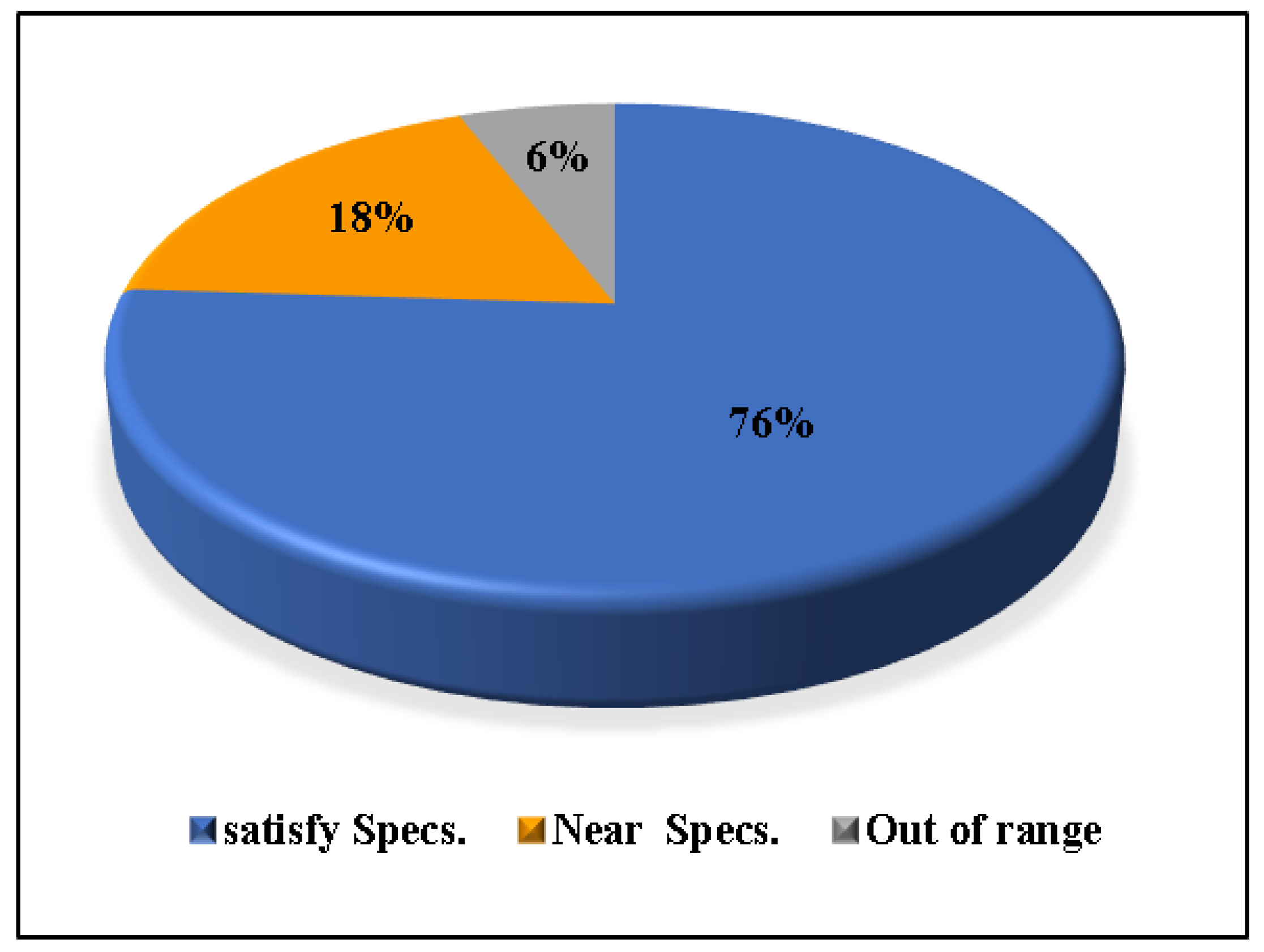
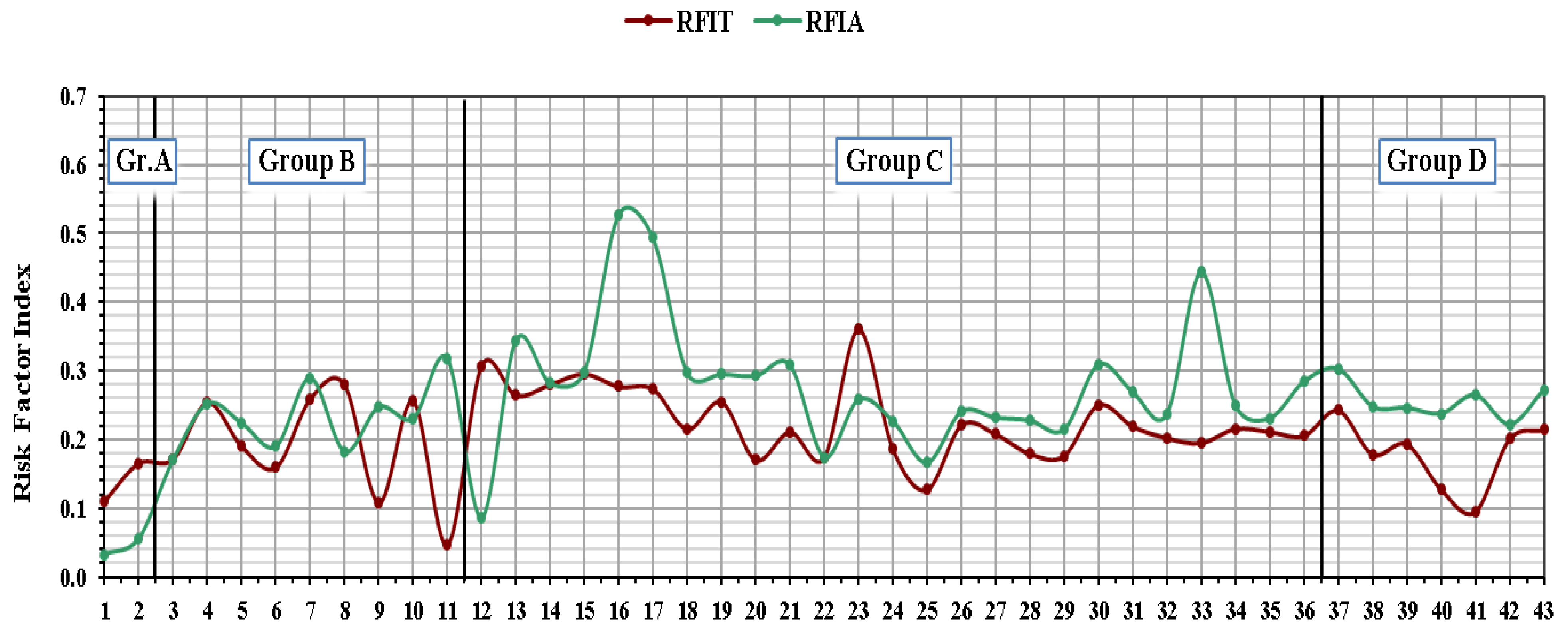
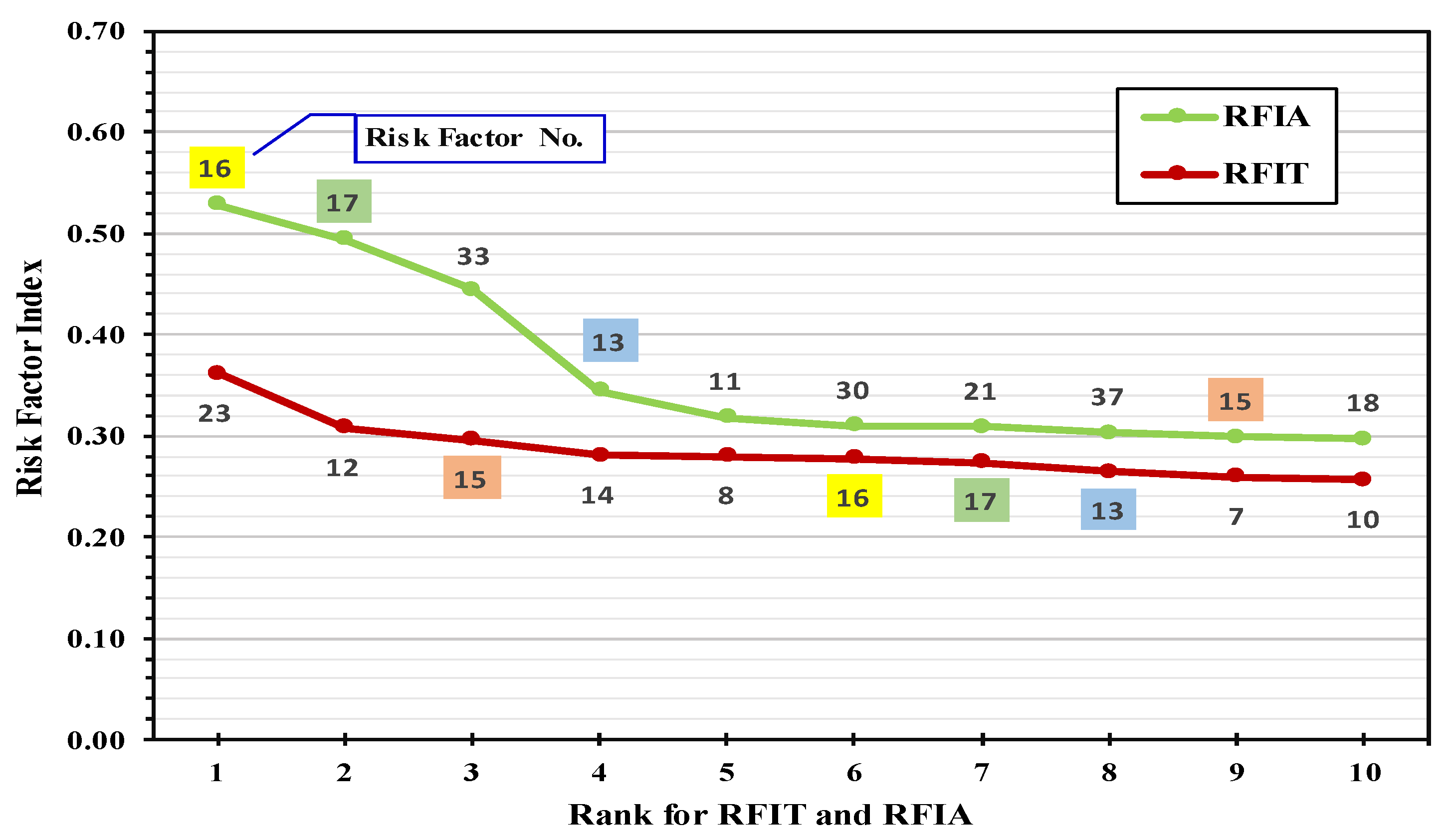
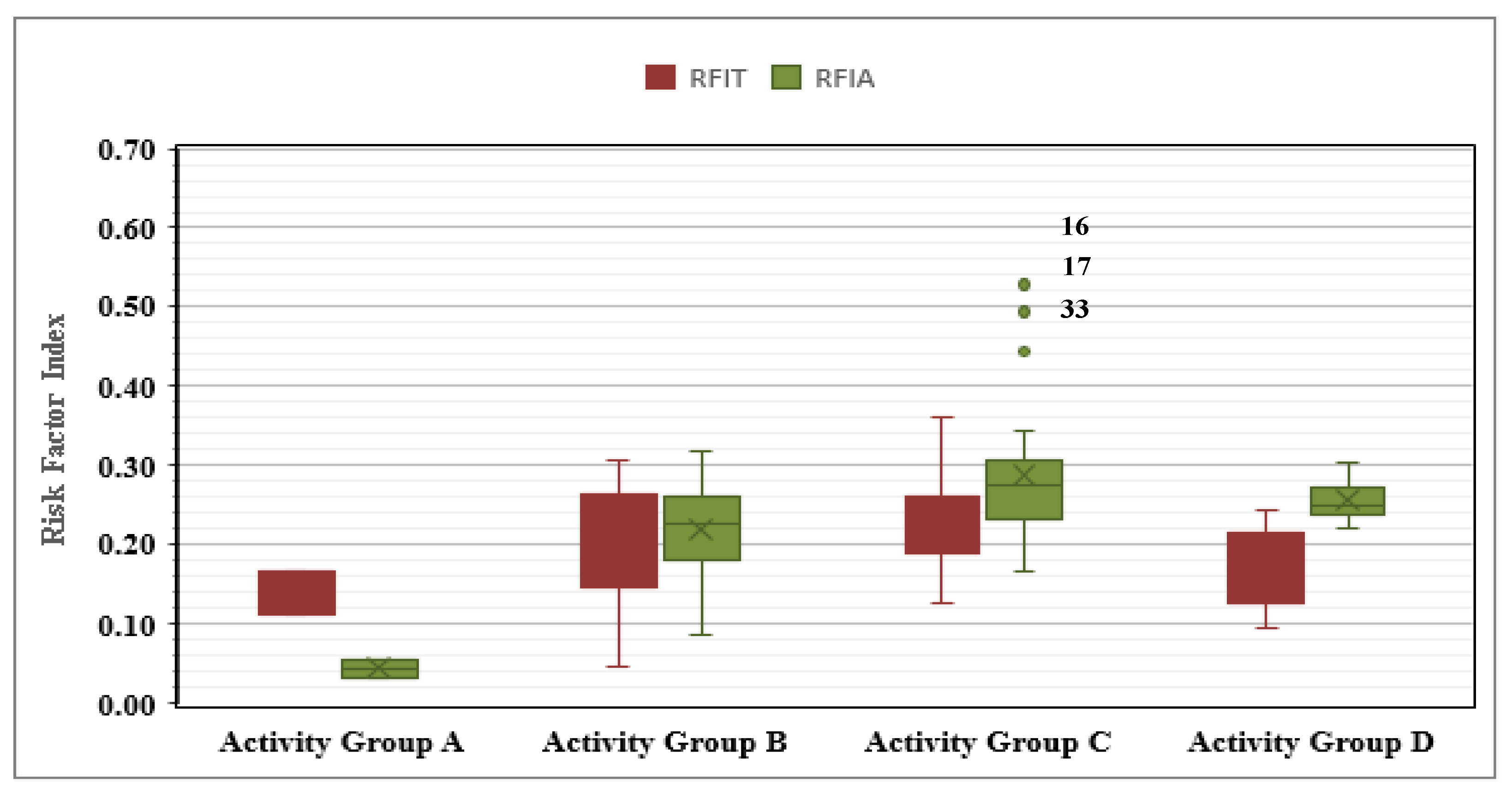
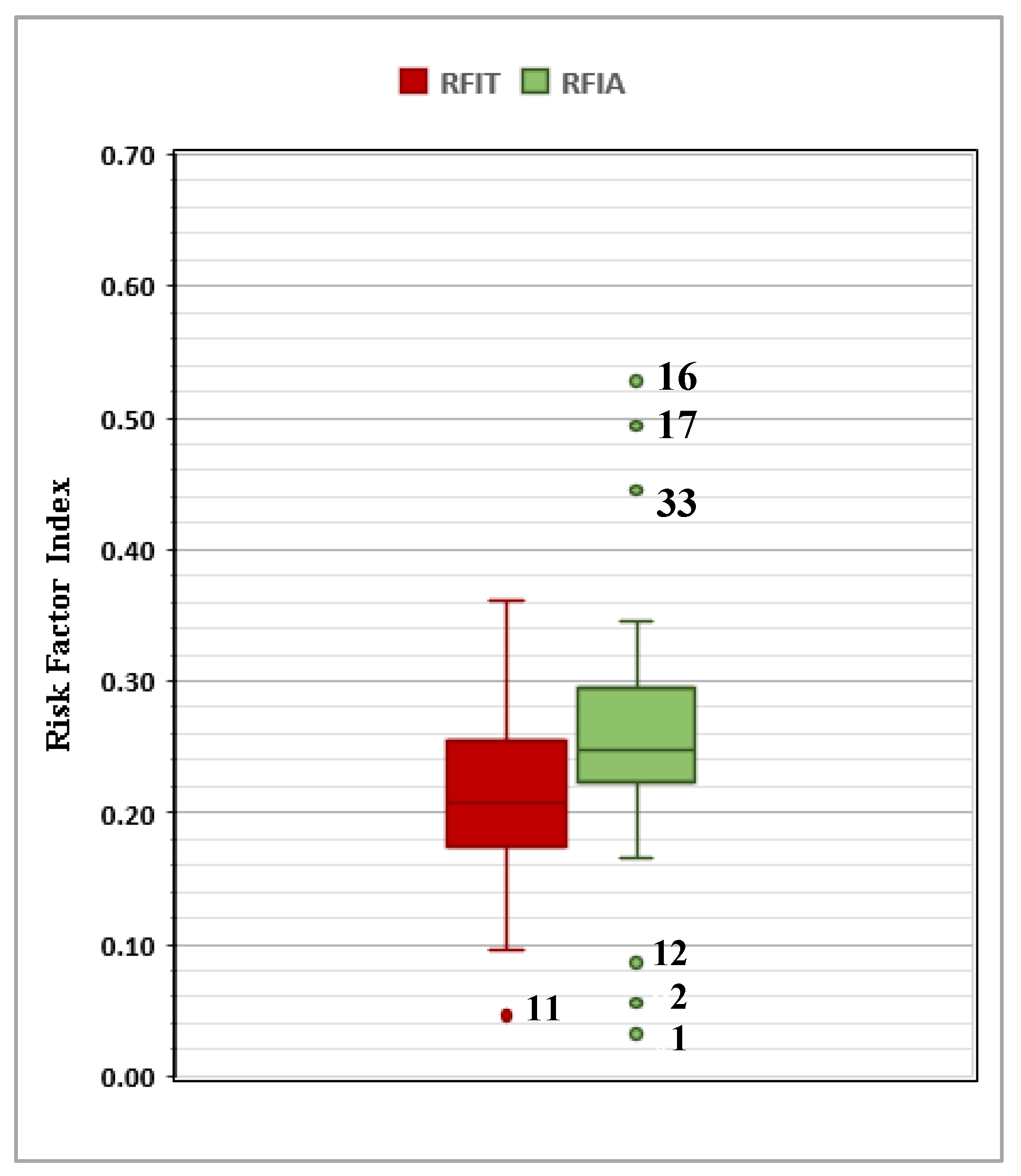
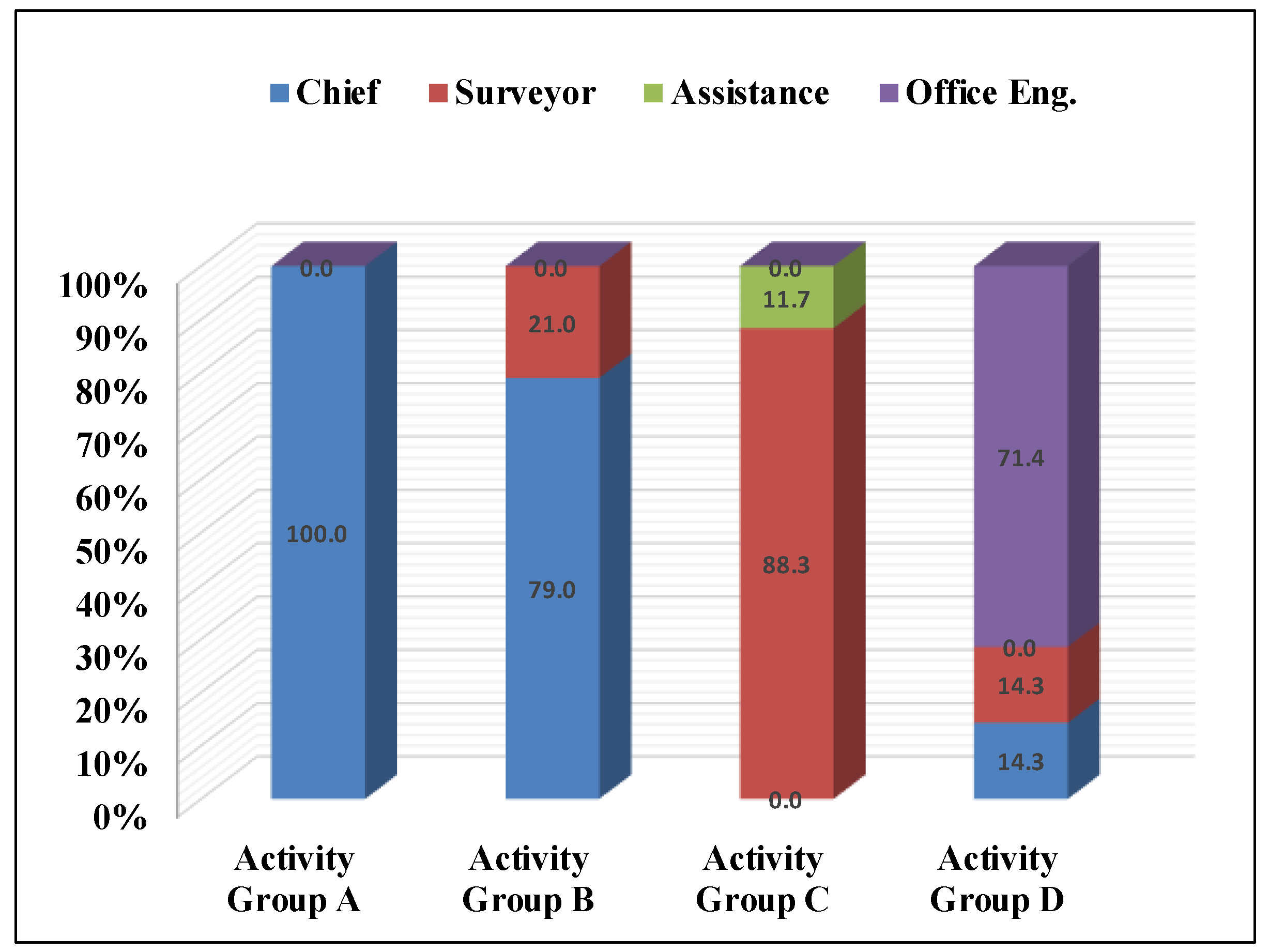
| Respondents | Contractors | Consultants | Total |
|---|---|---|---|
| Questionnaire Distributed | 76 | 64 | 140 |
| Responses Received | 54 | 35 | 89 |
| Response Rate | 71.05% | 54.69% | 63.57% |
| Percentage | 60.67% | 39.33% | 100.00% |
| NO. | Activity Group (A): Reconnaissance Works |
| 1 | Absence of reconnaissance works for exploring site conditions and availability of infrastructures. |
| 2 | Shortage in implementation of reconnaissance works. |
| Activity Group (B): Planning Works | |
| 3 | Absence of pre-established (predetermined) procedure in all stages of the survey to reduce the effect of mistakes and blunders. |
| 4 | No selection for an observation method to eliminate known systematic errors, such as face left and face right. |
| 5 | Absence of preventive procedures which eliminate most instrumental errors. |
| 6 | Poor selection for technologies, suitable instruments and type of survey according to the purpose and accuracy requirements. |
| 7 | Lack of proper planning and preparation. |
| 8 | Poor selection of improper points sites that do not meet specifications and precautions. |
| 9 | Bad selection of point positions and geometry (improper magnitude for horizontal angles between points). |
| 10 | Poor planning and bad selection for observation time which affect signals received from GPS and accuracy. |
| 11 | Inconsistency between precision of angular measurements and precision of linear measurements. |
| 12 | Absence of pre-determined scale for the produced map to specify the details that can be taken and measured. |
| Activity Group (C): Data collection works | |
| 13 | Absence of applying the engineering and surveying specifications necessary for the measurements. |
| 14 | Not following a determinable observation method (technique) to avoid and eliminate systematic errors. |
| 15 | Absence of appropriate preventive procedures (such as repeated measurements) to eliminate most of the instrumental errors. |
| 16 | Transferring The instrument and sights from control point to other one instead of making mounted tribrach stay on the tripod over that points for all uses without disturbing the tribrach setup. |
| 17 | Poor checking instrument settings when it is received by a crew, whether new or transferred from another crew. |
| 18 | Carefully read and call out each reading (observation) to the recorder. so, any large blunders will be caught. |
| 19 | Absence of carefully analyzing observation sheets. There are some important items should be checked in the field by the recorder. |
| 20 | Absence of measuring the angle used to calculate the inaccessible distances with a high degree of accuracy. |
| 21 | Using sight distances that bad fit the terrain and are not comfortable for the observer. |
| 22 | Lack of elimination parallax before any readings are made. |
| 23 | Taking measurements at inappropriate times (just before and after noon), where the impact of refraction is greatest. |
| 24 | Turning through side shots to accomplish the work, rather than observing via control points. |
| 25 | Transposing two numbers (in field notes or computer input). |
| 26 | Changing instrument settings or value of constants unintentionally during observing. |
| 27 | Setting up (placing) the instrument or the rod at a wrong point (station). |
| 28 | Using the incorrect values for coordinates or benchmark. |
| 29 | Use incorrect units (feet instead of meters). |
| 30 | Uncertainty of holding the range pole (rod) perfectly in the direction of the plumb line. |
| 31 | Incorrect input value for prism constant or incompatible with the setting of the prism on target when using EDM. |
| 32 | Uncertainty of temporary adjustment (Parallax - setup - centering) when beginning to operate a new instrument. |
| 33 | Lack of honesty among some observers, such as accepting an error greater than what is permitted. |
| 34 | The tripod is not in good condition and some parts are not well fitted |
| 35 | The instrument is not exactly over the point (centering). |
| 36 | Not following different pointing techniques that should be used depending on the type and apparent size of the target. |
| Activity Group (D): Data adjustment works | |
| 37 | Lack of correction or modeling of natural errors in adjustment process. |
| 38 | Absence of necessary corrections due to weather conditions. |
| 39 | Ignoring the ionosphere effect in adjustment on GPS surveying. |
| 40 | Inconsistency precision in angular and linear measurements. |
| 41 | Use of insufficiently accurate computation equations. |
| 42 | Lack of redundant observations to check observations. |
| 43 | End observations without locking on a control point (B.M.) to detect the closed error and ensure that it is permitted. |
| PI | IIT | IIA | RFIT | RFIA | |
|---|---|---|---|---|---|
| PI | 1 | −0.445 | −0.297 | 0.575 | 0.634 |
| IIT | −0.445 | 1 | 0.129 | 0.312 | −0.411 |
| IIA | −0.297 | 0.129 | 1 | −0.094 | 0.323 |
| RFIT | 0.575 | 0.312 | −0.094 | 1 | 0.388 |
| RFIA | 0.634 | −0.411 | 0.323 | 0.388 | 1 |
| Rank | Factor No. | RFIT | Activity Group | Rank | Factor No. | RFIA | Activity Group |
|---|---|---|---|---|---|---|---|
| 1 | 23 | 0.361 | C | 1 | 16 | 0.528 | C |
| 2 | 12 | 0.308 | B | 2 | 17 | 0.494 | C |
| 3 | 15 | 0.296 | C | 3 | 33 | 0.445 | C |
| 4 | 14 | 0.280 | C | 4 | 13 | 0.345 | C |
| 5 | 8 | 0.280 | B | 5 | 11 | 0.318 | B |
| 6 | 16 | 0.278 | C | 6 | 30 | 0.310 | C |
| 7 | 17 | 0.274 | C | 7 | 21 | 0.309 | C |
| 8 | 13 | 0.265 | C | 8 | 37 | 0.303 | D |
| 9 | 7 | 0.260 | B | 9 | 15 | 0.299 | C |
| 10 | 10 | 0.257 | B | 10 | 18 | 0.297 | C |
| RFIT | RFIA | ||
|---|---|---|---|
| Mean | Activity Group A | 0.14 | 0.04 |
| Activity Group B | 0.20 | 0.22 | |
| Activity Group C | 0.22 | 0.29 | |
| Activity Group D | 0.18 | 0.26 | |
| ALL Factors | 0.21 | 0.26 | |
| Std. Deviation | 0.06 | 0.09 | |
| Minimum Range | 0.05 | 0.03 | |
| Maximum Range | 0.36 | 0.53 | |
| Activity Group | Risk Factor No. | Percentage of Responsibility | |||
|---|---|---|---|---|---|
| Chief | Surveyor | Assistance | Office Eng. | ||
| Activity Group A: Reconnaissance Works | 1 | 100 | - | - | - |
| 2 | 100 | - | - | - | |
| Activity Group B: Planning Works | 3 | 100 | - | - | - |
| 4 | 100 | - | - | - | |
| 5 | 50 | 50 | - | - | |
| 6 | 100 | - | - | - | |
| 7 | 100 | - | - | - | |
| 8 | 30 | 70 | - | - | |
| 9 | 50 | 50 | - | - | |
| 10 | 80 | 20 | - | - | |
| 11 | 80 | 20 | - | - | |
| 12 | 100 | - | - | - | |
| Activity Group C: Data collection works | 13 | - | 100 | - | - |
| 14 | - | 100 | - | - | |
| 15 | - | 100 | - | - | |
| 16 | - | 80 | 20 | - | |
| 17 | - | 100 | - | - | |
| 18 | - | 50 | 50 | - | |
| 19 | - | 100 | - | - | |
| 20 | - | 100 | - | - | |
| 21 | - | 100 | - | - | |
| 22 | - | 100 | - | - | |
| 23 | - | 100 | - | - | |
| 24 | - | 100 | - | - | |
| 25 | - | 50 | 50 | - | |
| 26 | - | 100 | - | - | |
| 27 | - | 50 | 50 | - | |
| 28 | - | 100 | - | - | |
| 29 | - | 100 | - | - | |
| 30 | - | 30 | 70 | - | |
| 31 | - | 80 | 20 | - | |
| 32 | - | 80 | 20 | - | |
| 33 | - | 100 | - | - | |
| 34 | - | 100 | - | - | |
| 35 | - | 100 | - | - | |
| 36 | - | 100 | - | - | |
| Activity Group D: Data adjustment works | 37 | - | - | - | 100 |
| 38 | - | - | - | 100 | |
| 39 | - | - | - | 100 | |
| 40 | - | - | - | 100 | |
| 41 | - | - | - | 100 | |
| 42 | 50 | 50 | - | - | |
| 43 | 50 | 50 | - | - | |
| Group | Percentages of Responsibility | |||
|---|---|---|---|---|
| Chief | Surveyor | Assistance | Office Eng. | |
| Activity Group A | 100.0 | - | - | - |
| Activity Group B | 79.0 | 21.0 | - | - |
| Activity Group C | - | 88.3 | 11.7 | - |
| Activity Group D | 14.3 | 14.3 | - | 71.4 |
| ALL Group Factors | 23.2 | 55.4 | 12.5 | 8.9 |
Publisher’s Note: MDPI stays neutral with regard to jurisdictional claims in published maps and institutional affiliations. |
© 2021 by the authors. Licensee MDPI, Basel, Switzerland. This article is an open access article distributed under the terms and conditions of the Creative Commons Attribution (CC BY) license (https://creativecommons.org/licenses/by/4.0/).
Share and Cite
Issa, U.; Alqurashi, M.; Salama, I. Qualitative Analysis of Risks Affecting the Delivery of Land Surveying Project Activities. Sustainability 2021, 13, 12645. https://doi.org/10.3390/su132212645
Issa U, Alqurashi M, Salama I. Qualitative Analysis of Risks Affecting the Delivery of Land Surveying Project Activities. Sustainability. 2021; 13(22):12645. https://doi.org/10.3390/su132212645
Chicago/Turabian StyleIssa, Usama, Muwaffaq Alqurashi, and Ibrahim Salama. 2021. "Qualitative Analysis of Risks Affecting the Delivery of Land Surveying Project Activities" Sustainability 13, no. 22: 12645. https://doi.org/10.3390/su132212645






